MIST
Magnetosphere, Ionosphere and Solar-Terrestrial
Nuggets of MIST science, summarising recent papers from the UK MIST community in a bitesize format.
If you would like to submit a nugget, please fill in the following form: https://forms.gle/Pn3mL73kHLn4VEZ66 and we will arrange a slot for you in the schedule. Nuggets should be 100–300 words long and include a figure/animation. Please get in touch!
If you have any issues with the form, please contact This email address is being protected from spambots. You need JavaScript enabled to view it..
Global dynamical network of the spatially correlated Pc2 wave response for the 2015 St. Patrick's Day storm
By Shahbaz Chaudhry (University of Warwick)
Space weather poses a risk to infrastructure including satellites and power systems. A key challenge within space weather is predicting the magnetospheric response during storms. In order to understand the dynamics of geomagnetic storms, we can study Pc waves which are field line resonances along closed field lines in the inner magnetosphere. Recently, SuperMAG and Intermagnet have released new second resolution data which allows higher frequency Pc2 (T=5-10s) waves to be resolved and studied globally. Generation mechanisms for Pc2 waves (which we focus on in this paper) include ion-cyclotron resonance at equatorial regions of the magnetosphere.
To better understand geomagnetic storms, we for the first time build a Pc2 wave dynamical network using the full set of 100+ ground-based magnetometer stations. A network graphs the connections (edges) between entities (nodes). An example includes airline networks, where the nodes are airports and edges are flight paths. Here we build dynamical networks where nodes and edges are time varying. Network edges will be built upon the cross-correlation between Pc2 waves observed magnetic field at pairs of ground-based magnetometer stations.
Our first results are a study of the 2015 St. Patrick's Day storm for an 8 hour time window around onset. Using this storm we have identified network parameters and have shown that these track the distinct phases of the storm in terms of spatial coherence of Pc2 wave activity. We show that the network responds to distinct phase of the storm, including southward or northward IMF and does not just track the average Pc2 power. Using these network parameters we can perform statistical studies across many storms and quantitatively benchmark space weather models with observations. In addition, this analysis can be easily extended to other Pc bands which have different generation mechanisms within the magnetosphere.
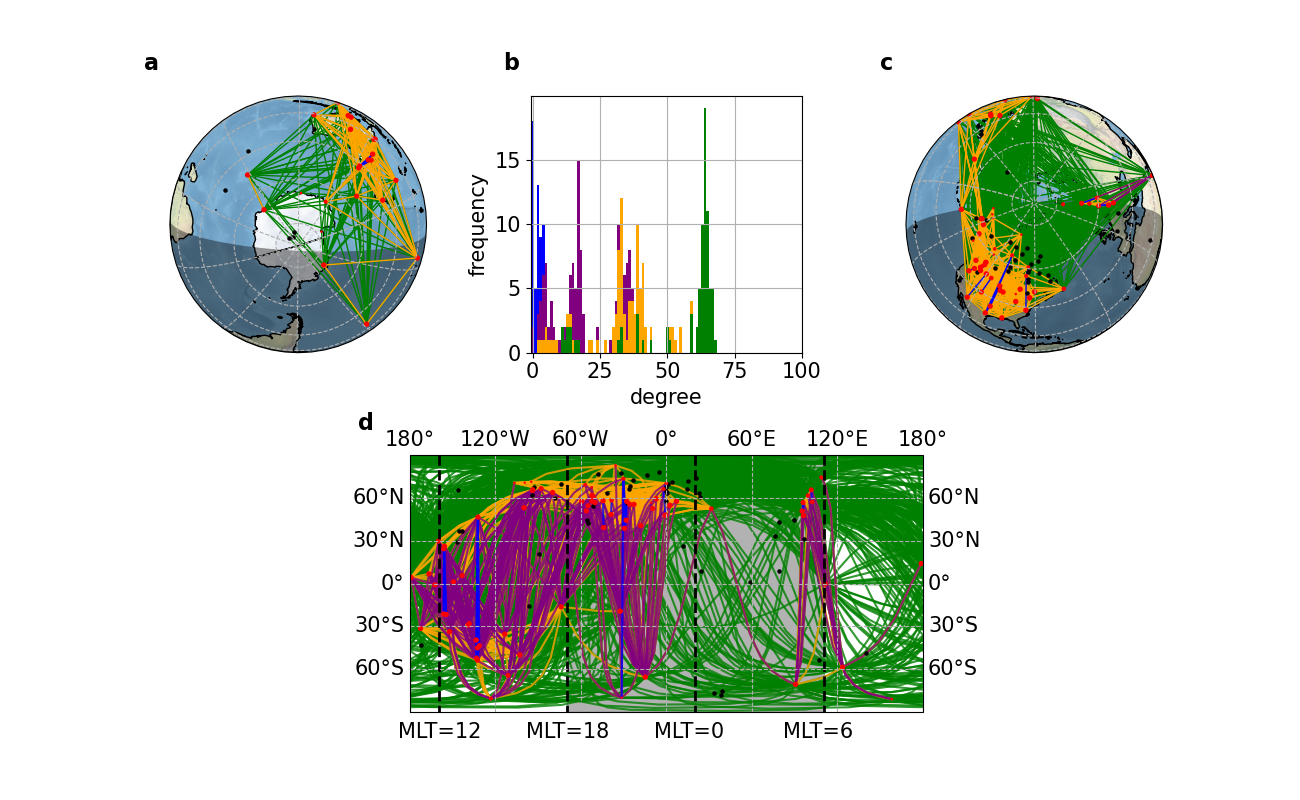
See paper for full details: , , , & (2023). Global dynamical network of the spatially correlated Pc2 wave response for the 2015 St. Patrick's Day storm. Journal of Geophysical Research: Space Physics, 128, e2022JA031175. https://doi.org/10.1029/2022JA031175
Formation and Motion of Horse Collar Aurora Events
By Gemma Bower (University of Leicester)
Horse collar aurora (HCA) are an auroral phenomena that occurs under northward IMF where the polar cap becomes teardrop shaped due to the poleward motion of the dusk and dawn sectors of the auroral oval. Their formation has been linked to prolonged periods of dual-lobe reconnection (DLR). This occurs when the same IMF magnetic field line reconnects in both the northern and southern hemisphere lobes when the IMF clock angle is small. This leads to the closure of magnetic flux at the dayside magnetopause. In order to further study the motion of HCA a list of HCA events previously identified in UV images captured by the Special Sensor Ultraviolet Spectrographic Imager (SSUSI) instrument on-board the Defense Meteorological Satellite Program (DMSP) spacecraft F16, F17 and F18 has been used. Events that have concurrent 630.0 nm all-sky camera (ASC) data from the Redline Geospace Observatory (REGO) Resolute Bay site are studied in more detail, making use of the higher cadence of the ASC images compared to DMSP/SSUSI. 11 HCA events are classified based on the IMF conditions at the end of the event. A southward turning of the IMF ends five events, two end with positive By dominated IMF and four with negative By dominance. The figure shows one of the studied events that ends with a southward turning of the IMF. Under positive (negative) By the arcs move duskward (dawnward) in the northern hemisphere with the opposite true in the southern hemisphere. Under a southward turning the arcs move equatorward. These results are in agreement with previously proposed models. Understanding the evolution of HCA will allow DLR to be studied in more detail.
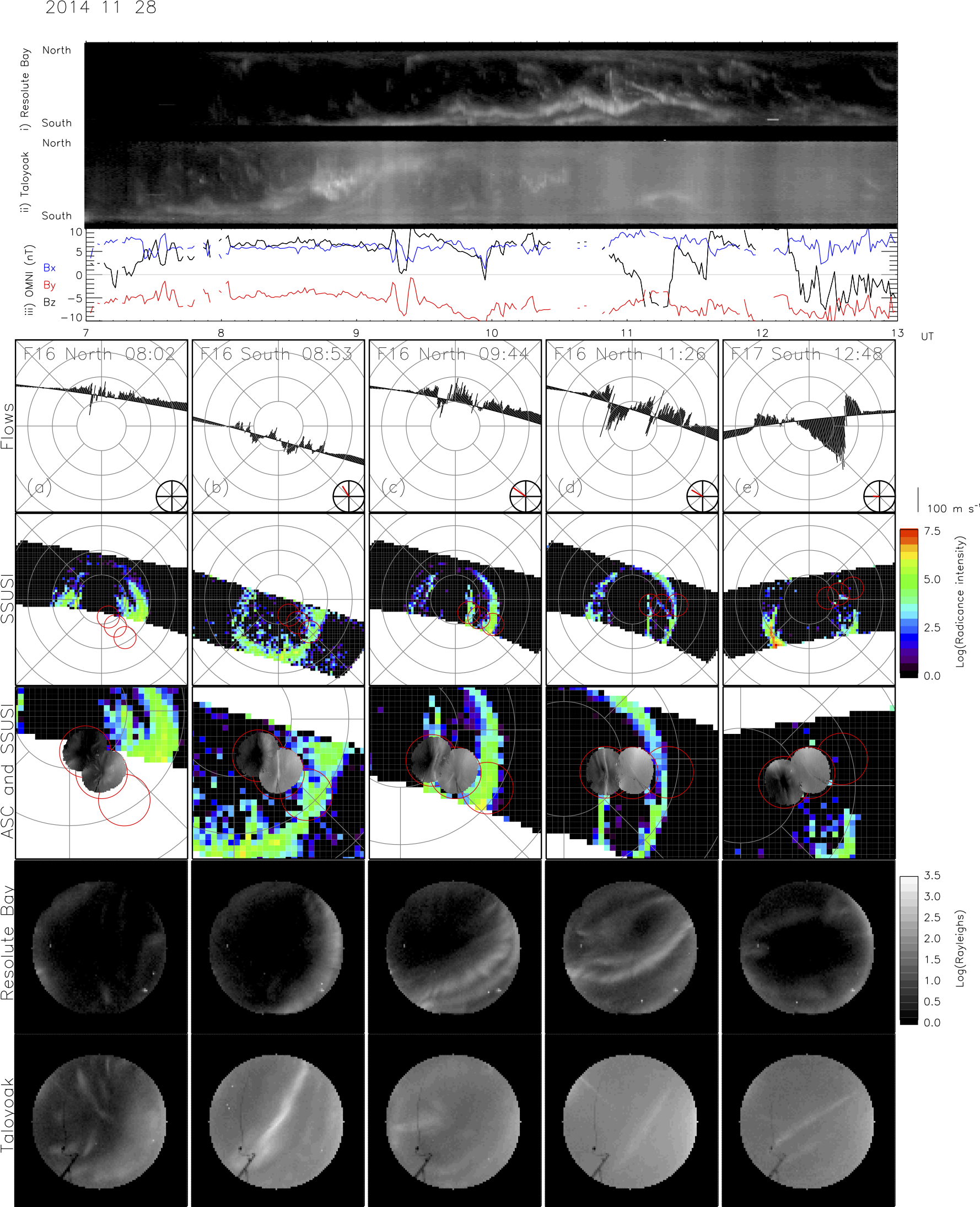
Please see paper for full details: Bower, Bower, G. E., Milan, S. E., Paxton, L. J., Spanswick, E., & Hairston, M. R. (2023). Formation and motion of horse collar aurora events. Journal of Geophysical Research: Space Physics, 128, e2022JA031105. https://doi.org/10.1029/2022JA031105
Will Space Weather Delay Your Train? – Modelling the Impact of Geomagnetically Induced Currents on Electrified Railway Signaling Systems in the United Kingdom
By Cameron Patterson (Lancaster University)
Railway signalling is one of the many ground-based systems that are susceptible to the impacts of space weather. A popular signalling system is the track circuit, where a line is split into smaller sections called ‘blocks’, each containing a power supply and a relay that sets the signal based on the level of current. Currents induced in the rails during geomagnetic events disrupt this balance, and have the potential to cause signalling misoperations, which can create delays and/or possibly be hazardous. Using recent theoretical work and parameters from industry standards documents, we have developed realistic models of two railway lines in the United Kingdom to study the impacts that geomagnetically induced currents have on signalling systems. In this study, we have focused on right side failures, which is when there are no trains occupying the blocks and green signals are turned red. Our results show that the susceptibility of a track circuit to induced currents is dependent on its length, orientation and position along the line. We found that the threshold electric field strength for a misoperation to occur is approximately what would arise during a storm expected to occur once every 30 years. Finally, we showed that with a 1 in 100 year extreme electric field, there would be a significant number of misoperations across the line.
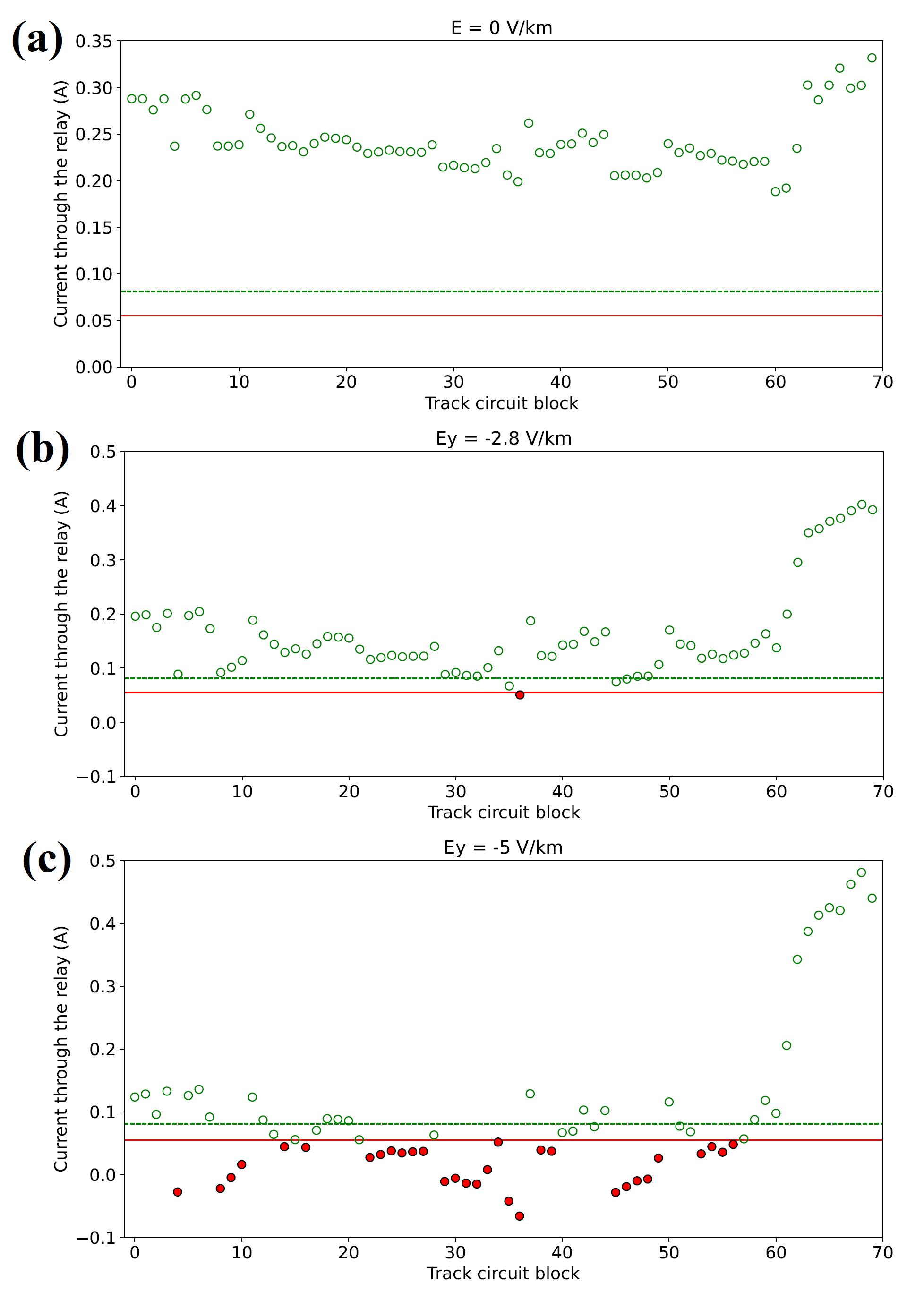
Please see the following paper for a more in depth look: Patterson, C. J., Wild, J. A., & Boteler, D. H. (2023). Modeling the impact of geomagnetically induced currents on electrified railway signaling systems in the United Kingdom. Space Weather, 21, e2022SW003385. https://doi.org/10.1029/2022SW003385.
Extreme Event Statistics in Dst, SYM-H, and SMR Geomagnetic Indices
Aisling Bergin (University of Warwick)
Extreme space weather events are rare, and quantifying their likelihood relies upon long-term continuous observations. High-quality ground-based magnetometer observations underpin geomagnetic indices that monitor space weather and span multiple solar cycles. The Dst index ring-current monitor, derived from an hourly average over four low-latitude stations, is a benchmark for extreme space weather events, and has been extensively studied statistically. Space weather storms cause magnetic perturbation that can be localized in space and time. Geomagnetic ring current indices are available which use a larger number of magnetometers than Dst: SYM-H (derived from 6 stations) and SuperMAG SMR (derived from up to 120 stations).
In this paper we perform the first extreme value theory (EVT) analysis of SYM-H and SMR. EVT analysis reveals a divergence between the return level found for Dst, and those for SYM-H and SMR, that increases non-linearly with return period. For return periods below 10 years, hourly averaged SYM-H and SMR have return levels similar to Dst, but at return periods of 50 and 100 years, they respectively exceed that of Dst by about 10% and 15% (SYM-H) and about 7% and 12% (SMR). One minute resolution SYM-H and SMR return levels progressively exceed that of Dst; their 5, 10, 50, and 100 year return levels exceed that of Dst by about 10%, 12%, 20% and 25% respectively. Our results indicate that consideration should be given to the differences between the indices if selecting one to use as a benchmark in model validation or resilience planning for the wide range of space weather sensitive systems that underpin our society.
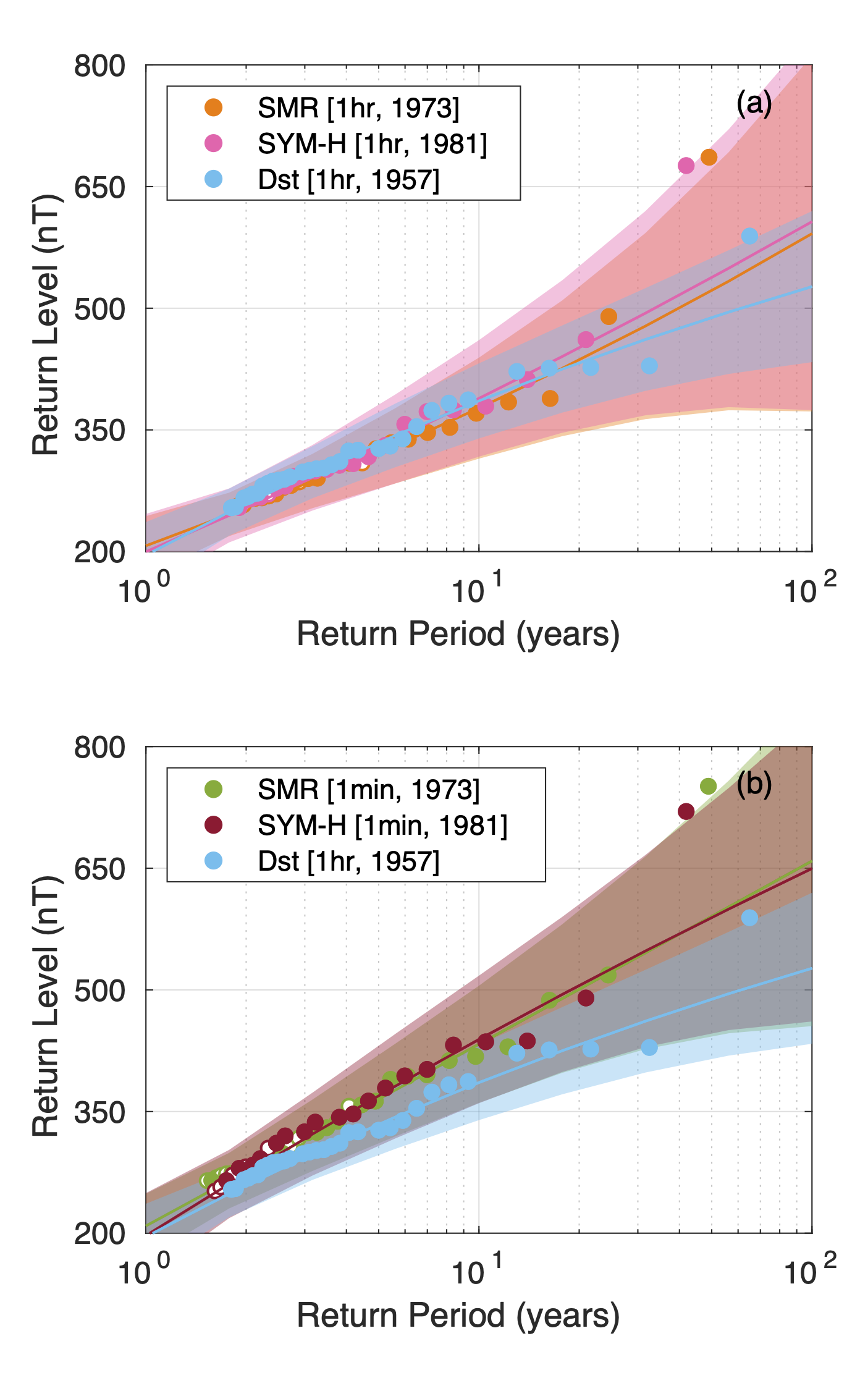
Please see the paper for full details: Bergin, A., Chapman, S. C., Watkins, N. W., Moloney, N. R., & Gjerloev, J. W. (2023). Extreme event statistics in Dst, SYM-H, and SMR geomagnetic indices. Space Weather, 21, e2022SW003304. https://doi.org/10.1029/2022SW003304
The predictive power of magnetospheric models for estimating ground magnetic field variation in the United Kingdom
Ewelina Florczak (British Geological Survey, University of Edinburgh)
Space weather events can have damaging effects on ground-based infrastructure. Geomagnetically induced currents caused by rapid magnetic field fluctuations during geomagnetic storms can negatively affect power networks, railways as well as navigation systems. To reduce such negative impacts, good forecasting capability is essential. In this study we assess the performance of contemporary magnetohydrodynamic (MHD) models in predicting the ground magnetic field perturbations at three UK observatories during two severe space weather events: September 2017 and March 2015. Simulated magnetic data were acquired via Community Coordinated Modeling Center1, using the following models: Space Weather Modeling Framework (SWMF), Open Geospace General Circulation Model (Open GGCM) and Lyon–Fedder–Mobarry (LFM) combined with the Rice Convection Model (RCM). Qualitative and quantitative comparison between measured and modelled values suggest that the performance of MHD models vary with latitude, the magnetic component and the characteristics of the storm analysed. Most models tend to exaggerate the magnitude of disturbances at lower latitudes but better capture the fluctuations at the highest latitude. For the two storms investigated, the addition of RCM tends to result in overestimation of the amplitude of ground perturbations. The observed data-model discrepancies most likely arise due to the many approximations required in MHD modelling, such as simplified solar wind input or shift in location of the electrojets in the simulated magnetospheric and ionospheric currents. It was found that no model performs consistently better than any other, implying that each simulation forecasts different aspects of ground perturbations with varying level of accuracy. Ultimately, the decision of which model is most suitable depends on specific needs of the potential end user.
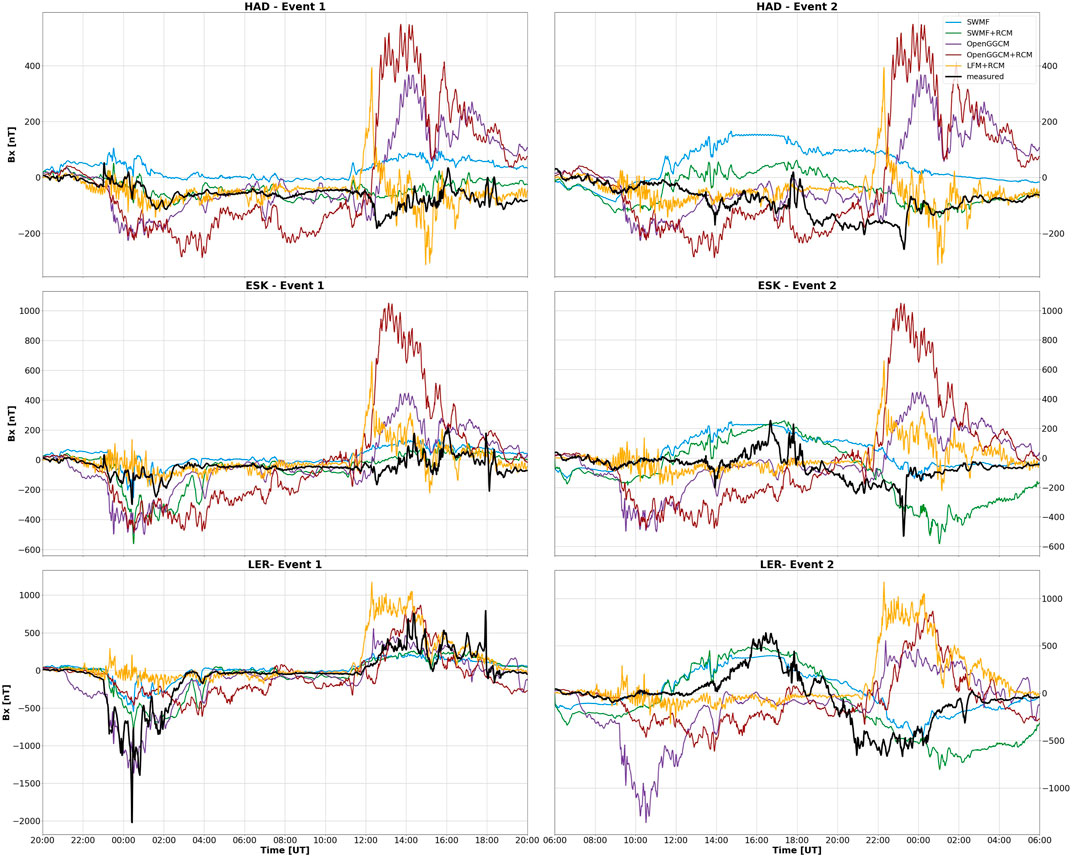
References:
For further details see Florczak E, Beggan CD and Whaler KA (2023) The predictive power of magnetospheric models for estimating ground magnetic field variation in the United Kingdom. Front. Astron. Space Sci. 10:1095971. doi: 10.3389/fspas.2023.1095971